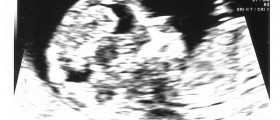
Not every newly pregnant woman has an implantation bleeding. In fact, only roughly a third of all of those who conceived will ever report experiencing a so-called implantation bleeding. Fertilized eggs make their way down from the fallopian tubes to the uterus, where they will try to implant into the lining of the uterus. Because this lining contains rather a lot of fleshy and bloody tissue, implantation is sometimes said to be marked by a bit of bleeding, which may in some women manifest as a slight spotting. The most notable difference between an implantation bleeding and your period is that an implantation normally occurs before your period is due. Most sources will tell you that it will happened any time from seven to ten days after your ovulation, since this is roughly when a fertilized egg would implant, but it has happened to some women even sooner than that.
Whatever the case, implantation bleeding will strike before you expect your period. Menstrual flow usually starts off with a few drops of blood, and then quickly progresses to larger amounts. The spotting that you notice with implantation bleeding is different in that it will stop at a few drops, and never progress. If you notice heavy blood flow before your period is due, and especially if you have other symptoms like pain and cramping, it is wise to get in touch with your health care provider, because these bleedings may be caused by a miscarriage or another gynecological health condition.
Sudden symptoms of heavy bleeding could be connected to an early miscarriage or even a chronic health condition, like endometriosis, but an implantation bleeding is very different — barely noticeable, something you may spot if you look down at your toilet paper after wiping.
When a fertilized egg implants itself into the lining of your womb, the tissue that is released needs a few days to travel down and come out. By the time you notice the spotting, it is likely to be dark red or brown in color, because it is already old blood. Some women have slight cramping along with their implantation bleeding, and those who are charting to conceive might notice another shift in their basal body temperature. For most, light spotting is the only symptom though. A missed period, which would be noticed a few days later, is the next symptom, which signals it's time to take a pregnancy test.

















Your thoughts on this
Loading...